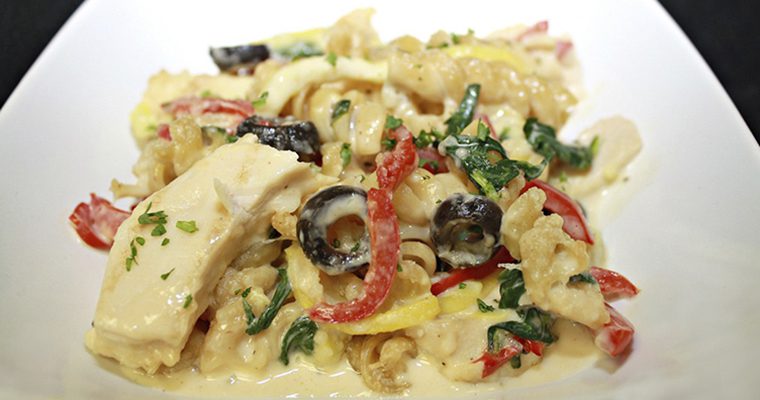After a year of pandemic uncertainty, K-12 school foodservice programs are ready to get cooking again. Speed-scratch recipes offer the convenience, nutrition and variety your staff and students will appreciate as they return to the cafeteria tables.
Post-pandemic appetites will want something other than the ready-made, carryout-style foods necessary during the 2020-21 school year. Speed-scratch cooking can help you meet the need no matter what size your dining program. Just ask the small Johnson Creek Schools District in Central Wisconsin or the huge Hillsborough County Public Schools near Tampa, Florida. Both see speed-scratch as a benefit for their teams and their students.
What is speed scratch?
Speed-scratch is simply removing some portion of the scratch cooking process to make the job easier. For example, a barbecue mac and cheese dish created with pre-cooked noodles, cheese sauce and smoked pork saves your team the time of cooking noodles, simmering a cheese sauce and slow-roasting pulled pork.
It allows a school kitchen to reduce time and provides opportunities to use one product in multiple recipes. At Hillsborough, District Chef Tom Mims explains that cooked beef crumbles get used in everything from a meaty marinara sauce to Santa Fe nachos, tacos, enchiladas and burritos. When you’re serving about 230,000 breakfast and lunch meals daily, finding products for multiple menu items is a must.
Variety also has a place at Johnson Creek, where Food Services Director Kassidy Wright has been working with a healthy schools grant to develop speed-scratch recipes. With just six employees preparing about 300 meals at an elementary and middle/high school, one place she’s always used speed-scratch products is on the salad bar. She calls on grain salads—pasta, quinoa, couscous—as well as egg or tuna salads. She also adds pre-cut vegetables to the salad bar.
“This year we couldn’t do a salad bar, but when students can serve themselves, the amount of options we can put out there is amazing,” she says. “And when they choose their own food, they eat better.”
Bowl builds are another speed-scratch opportunity. Gordon Food Service Business Solutions Specialist Molly Armstrongpoints out to recipe bars where students can create a burrito bowl or an Asian-style chicken bowl, similar to the popular Chipotle concept.
Making speed-scratch work
Both school systems create a speed-scratch poultry pot pie that’s a menu favorite. At Johnson Creek, the recipe calls for quick-frozen peas, carrots and corn, commodity turkey, gravy and homemade biscuits.
At Hillsborough, Mims calls on a recipe inspired by his time working for The Cheesecake Factory. “I was inspired to do their version of chicken and biscuit,” he says. “It’s speed scratch because we use a couple of different sauces that are premade. We also use chicken protein that is premade, and we have a very good Pillsbury biscuit—a white, tear-apart biscuit that’s the base of the whole recipe.”
In both cases, the joy of speed-scratch cooking is that there are a lot of culinary aspects involved. The Hillsborough team builds a roux, thickening the ingredients on a tilt skillet gallons at a time. A JTM alfredo sauce and Heinz cream of mushroom soup add layers of flavor, and the chefs add seasonings as they go. The finished dish is plated as an open-face pot pie.
Other popular dishes include ethnic favorites. At Johnson Creek, “The kids are always telling me they love the pork enchiladas—commodity pork roast, special seasonings, peppers and onions that get cooked together, wrapped in corn tortillas and smothered in a pre-made enchilada sauce and pre-shredded cheese,” Wright says.
At Hillsborough, the menu includes Latin, Caribbean, Cajun, traditional American, Italian—”We’re testing recipes from India right now with Chicken Tikka Masala,” Mims says.

The role of training and consistency
With a staff of more than 1,800, Mims says the secret of making speed-scratch successful is training and consistency. It’s easy to be sold on the potential for product and labor cost savings, and everyone’s goal is to manage ingredients and nutritionals, but all can be lost without proper oversight.
“My focus for the past five years has been heavy front-end training on culinary concepts,” Mims notes. “We talk about how to measure, the science of cooking food, the equipment … everyone has to talk the same culinary language and perform the same recipes.”
Failure to properly measure ingredients or consider quality could mean throwing out a 15-gallon batch of sauce and losing all of the savings.
Wright agrees, relying on menu standardization through the USDA website with approved recipes. “I think it’s important to standardize recipes so you can prove your menu meets requirements. You can standardize them yourself or use software, depending on what sources are available to you.
Getting started with speed-scratch
There are lots of ways schools can get speed-scratch ideas. Vendors—JTM, Tyson, Waypoint, General Mills, Kellogg’s, etc.—offer recipe ideas. Online discussion groups, such as Facebook’s “Tips for School Meals that Rock.” are a good source. And the Gordon Food Service Culinary Specialists are always available to help.
“It’s a topic that comes up for all operators, and we can help,” says Gordon Food Service Business Solutions Specialist Kym Wroble. “We work with vendors to find new ways to use products and add convenience to things that were once scratch cooking.”
Speed-scratch is one way schools can get cooking again. It energizes culinary creativity and brings delicious food to the table.
“Speed-scratch helps you take pride in your work. You are very proud of what you make, and it’s worth it in the end,” Wright says. “Our participation was up, the kids were eating more, our fresh vegetables intake went up—we have a very healthy cafeteria because we are participating in speed-scratch.”










